We may earn revenue from the products available on this page and participate in affiliate programs. Learn More ›
I’ve been lucky enough to own and handle many of the best pocket knives, including production and custom blades. Now, the Fifth Amendment protects me from self-incrimination, so I won’t say how many knives I currently own, or have owned, because it’s possible that my wife will read this. However, I will say that I have been a prolific purchaser of cutlery since I got my first knife at age 5. I even started a sharpening business years ago just to fund my “hobby.”
If you don’t want a drawer(s) full of knives and just want to find the best pocket knife for you, I’ve put together a list of the best pocket knives for a variety of users and uses. I didn’t randomly pick the following knives out of a hat. I’ve had many knives pass through my hands on the sharpening bench and in my collection, and have learned a lot about what makes a great pocket knife through hands-on experience. Nobody wants second-best anything, so here are my picks for the best pocket knives.
Best Pocket Knives: Reviews and Recommendations
Best Overall: Kershaw Bel Air
Photo by Scott Einsmann
See It
Pros
- Good action
- Great blade shape and grind for EDC tasks
- Thin and easy to carry
- Excellent ergonomics
Cons
- Aluminum scales lack traction
Key Features
-
KVT ball bearings -
Lock Type:
DuraLock -
Pocket Clip:
Reversible deep-carry (right/left, tip-up) -
Warranty:
Limited lifetime warranty -
Blade Length3.1 inches -
Blade Material:
CPM MagnaCut -
HRC:
62 to 64 -
Blade Finish/Coating:
BlackWash -
Blade Thickness:
0.09 inches -
Closed Length4.2 inches -
Handle Material:
6061-T6 aluminum -
Handle Finish/Coating:
Cerakote -
Handle Thickness:
0.44 inches -
Overall Length:
7.3 inches -
Weight:
2.9 ounces -
Price:
$150
My first impressions of the Bel Air set a high bar. When I took the Bel Air out of its box, I flicked it open and experienced one of the best crossbar lock actions I’ve handled. The quality build is immediately evident and with a Mangnacut blade, it’s offered at a great price ($160).

A look at the Bel Air’s action and cutting ability.
The Bel Air truly impressed me when I tested it head to head against the WE Banter — one of my favorite EDC blades. The Banter has a slightly better action, but the Bel Air cuts circles around the Banter. Its blade flew through cardboard, dug deep into wood, and breezed through various cordage.
Of all the EDC knives I’ve tested this year, the Bel Air is the most refreshing. A lot of companies are taking serious flack for pricing knives way too high. Yet, here is a knife that’s priced very fairly for its materials, performance, and country of origin. I’m safely calling this the best value in American made knives and a great buy for anyone looking for a quality pocket knife. The only criticism I have for this knife is a lack of traction on the aluminum scales. — Scott Einsmann, gear editor
Read Next: Best Knives Made in the USA
Best Value: Civivi Yonder
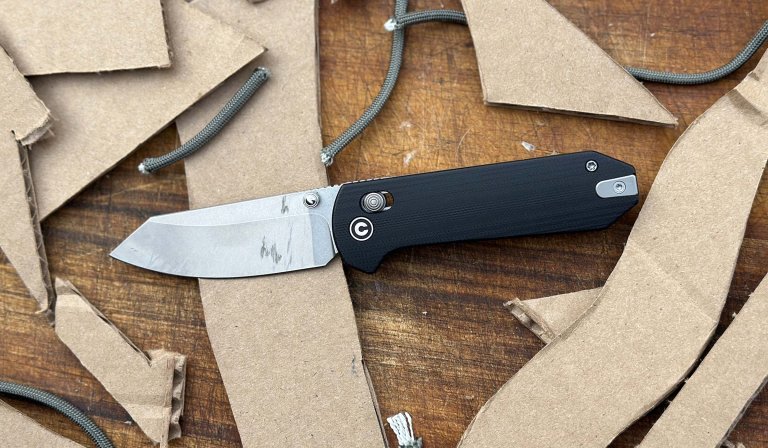
Photo by Scott Einsmann
See It
Pros
- Good all-around cutter
- Very comfortable ergonomics
- Easy to carry
- Compact, but still plenty of grip real estate and blade
Cons
- Not the best for cutting cordage
Key Features
-
Price:
$67 (Retails for around $60) -
Very lefty friendly -
Weight:
2.8 ounces (measured) -
Closed Length:
3.74 inches (measured) -
Open Length:
6.63 inches (measured) -
Thickness:
0.45 inch (measured) -
Blade Stock Thickness:
0.09 inch (measured) -
Thickness Behind the Edge:
0.01 inch (measured) -
Sharpened Edge Length:
2.73 inches (measured) -
Spade-point blade -
Blade Material:
14C28N -
Blade Hardness:
58-60HRC -
Crossbar lock -
G10, micarta, or wood scales -
Caged ceramic ball bearings -
Designer:
Zac Whitmore
The Civivi Yonder was an exciting new release in 2024, and after testing it head to head against the Kershaw Bel Air and the CJRB Pyrite Light, it became one of my favorite pocket knives of all time. Especially when you consider its $60 price tag.
The Yonder is a good general purpose slicer thanks to its thin grind and sweeping belly. The Yonder’s spine measures 0.09-inch thick and just behind the edge, the Yonder measures 0.01-inch thick. I tested on thick cardboard and its blade geometry carved it up with ease. I also cut paracord, which would slip down the blade before being cut due to the knife’s belly.
In the pocket, the Yonder is among the best I’ve carried. It’s out of the way, discreet, and easy to deploy when needed. Read my full Civivi Yonder review to learn more. — Scott Einsmann
Best for $100: WE Banter
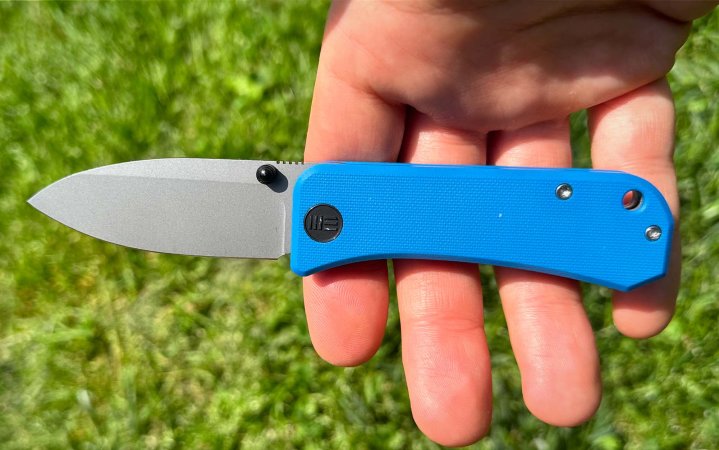
Photo by Scott Einsmann
See It
The WE Banter was one of the most surprising successes of the entire test. The knife doesn’t look like much—a simple blade and handle design. But when I hit its thumb stud I was immediately impressed by its satisfying action. Then I was blown away at how it chewed through the oak dowel quickly, and it did so without inducing even the slightest hot spot. That performance shook up my expectations of what a small knife can do.
The action though, is really something special. It has that premium knife feel and an audible click as the blade locks open that is oh so sweet. You can easily pay three times the price of a Banter for the same experience. Like the Arcade, it wasn’t the top finisher at any one phase of the cut test, but very good at all of them. If you have a $100 budget, this is one of the best EDC knife options out there.
Also Consider: WE’s more affordable brand, Civivi, makes a Banter model that’s around $50. It’s the same design with budget materials.— Scott Einsmann, gear editor
Best Budget: Civivi Qubit
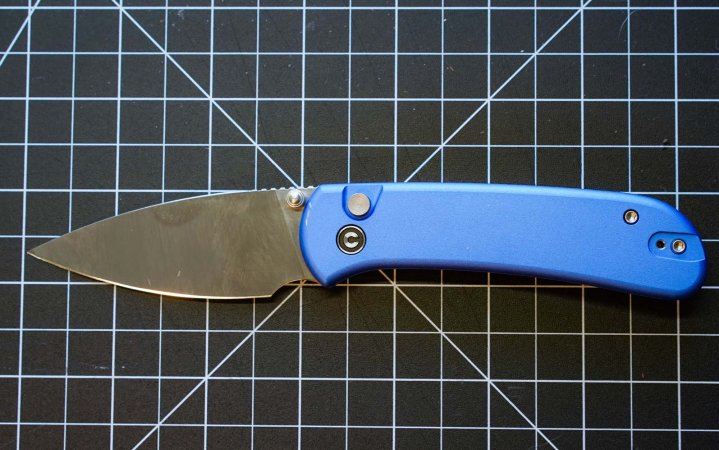
Scott Einsmann
See It
Pros
- Lefty friendly
- Great slicer
- Snappy action
Cons
- Finger choil is a little too small
Key Features
-
Blade Length:
2.98 inches -
Overall Length:
7.19 inches -
Weight:
2.82 ounces -
Blade Steel:
14C28N -
Deployment Method:
Thumb stud -
Button lock -
Aluminum handles -
Made in China -
Price:
$60

I tested so many great knives under $100 that I’m compelled to write a dedicated review on them. One that stood out in that impressive crowd was the Qubit. It out-cut all the others with its thin blade geometry and the nicely sculpted aluminum handles were comfortable during the toughest cuts. The Qubit’s biggest competition was the CJRB Pyrite. They’re both button locks with nice snappy actions. But the Qubit cut slightly better and lacked the Pyrite’s hotspots during heavy cutting. — Scott Einsmann, gear editor
Best Slipjoint: QSP Hedgehog
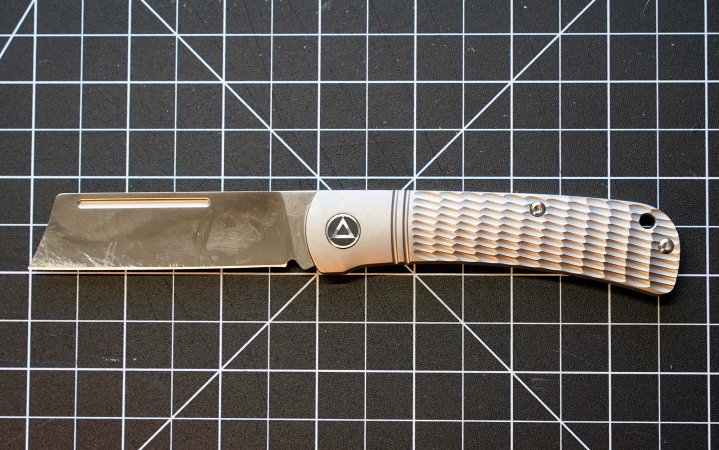
Scott Einsmann
See It
Pros
- Light and easy to carry
- Deep hollow grind makes for a slicey blade
- Great walk and talk
- Good fit and finish
Cons
- Some slipjoint enthusiasts will prefer a more traditional pattern
Key Features
-
Blade Length:
2.875 inches -
Overall Length:
6.6 inches -
Weight:
2.7 ounces -
Deployment Methods:
Nail nick and blade pinch -
Blade Material:
M390 -
Titanium or carbon fiber covers -
Price:
$145 (titanium) or $85 (carbon)

I went from a slipjoint curious collector to carrying one daily, and among my pocket regulars is the excellent QSP Hedgehog.
The sheepsfoot blade is easy to pinch and I’d judge the pull strength at a 6—slightly more than a Swiss Army Knife. It snaps into the half stop and then again into the open position. The walk and talk on the Hedgehog is a treat and while different from my Jack Wolf and Northwoods knives, is no less satisfying. It has a very unique sound, especially when opening to the half stop.
The blade is tall and features a deep hollow grind, which makes it an incredible slicer. It’s one of the most fun knives to cut with and it passes through rope, cardboard, and plastic with very little resistance. — Scott Einsmann, gear editor
Best Ultralight: Benchmade Bugout 535-3
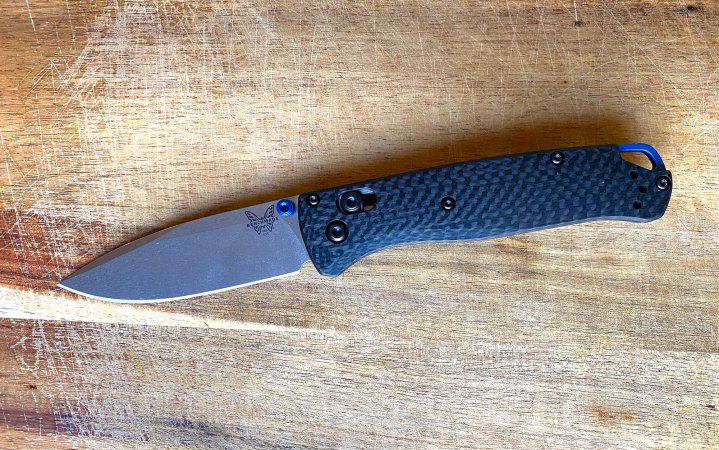
See It
Pros
- Great edge retention
- Extremely light
Cons
- Some fit and finish flaws
Key Features
-
Blade Length:
3.25 inches -
Steel:
S90V -
Handle:
Carbon fiber -
Weight:
2 ounces -
Lock:
Axis -
Price:
$298
The Benchmade Bugout comes in several trim levels, ranging in price from $160 to $540. The price fluctuates with the materials. If you want a super steel and carbon fiber, it’s going to cost you. But, all the models share the same blade shape, ergonomics, and locking mechanism.
The Bugout has a drop-point blade that puts the tip in the knife’s centerline. That feature makes it intuitive to know where the point is while you’re working. The belly has a gentle sweep, which is useful for a lot of cutting tasks. If I had to choose one blade shape for all my knives, the Bugout’s drop point would be it.
In a pinch grip or power grip, the Bugout is fantastically comfortable and the handle is deceptively detailed. The top of the handle has a slight drop from front to back. The bottom of the grip locks your index finger into place to prevent slipping and has just enough of a pinkie hook to give you extra grip. The pocket clip is reversible and the thumb studs are easy to hit with a thumb or middle finger. The axis lock makes one handed opening and closing a cinch. You can buy a Bugout with S30V, S90V, or M390 steel. All three steels are close in their toughness. M390 has the best corrosion resistance, S90V has the best edge retention, and S30V is the most affordable. -Scott Einsmann
Read our full review of the best electric knife sharpeners if you’re looking for a quick and easy way to sharpen your pocket knives.
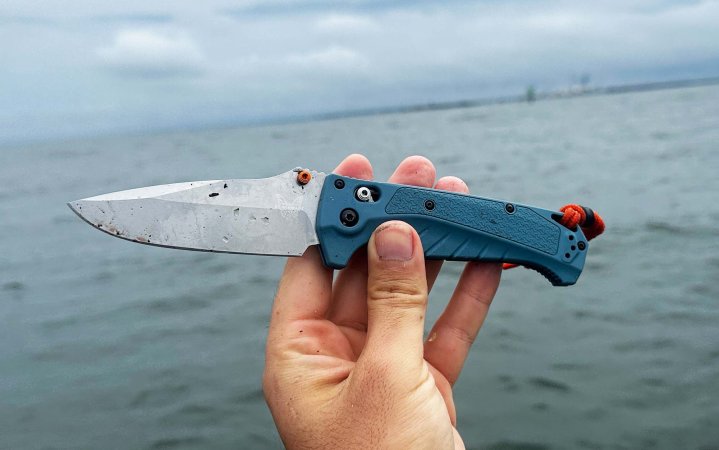
Photo by Scott Einsmann
See It
Pros
- Highly corrosion resistant
- Durable blade shape and edge grind
- Comes very sharp from the factory
Cons
- I’d prefer a thinner, slicier blade for this role
Key Features
-
Blade Length:
3.8 inches -
Overall Length:
9 inches -
Weight:
4.2 ounces -
Available in full size and mini -
Deployment Methods:
Thumbstud -
Blade Material:
Magnacut -
Grivory handle -
Price:
$250
If you take a standard pocket knife, even in a stainless steel, and submerge it in saltwater you’ll get some rust spots. Not to mention the damage saltwater will do the screws, bearings, and other small parts. But, the Adira is built to treat that type of abuse as just another day on the job. I wore the Adira swimming in saltwater, and didn’t rinse it after. A week later it was still pristine. I’ve been using it as my go-to kayak fishing knife where it cuts bait and bleeds out fish. Its sharp edge and Maganacut’s inherent toughness means I can go right through bones and gill plates without worrying about edge damage.
The full size option is a big knife, and I think most people will prefer the mini for EDC and typical cutting tasks. If you’re a diver, crabber, or you’ll use the Adira as a bait knife, the full size option is the way to go. Its long blade is ideal for cutting rope and you’ll have plenty of purchase even when wearing gloves.
It’s worth noting that Magnacut is highly stain resistant, but it’s not the most rust proof steel option available. I’d recommend rinsing and drying the knife after a dip in the salt, even though mine has thrived on neglect. Do as I say, not as I do.
— Scott Einsmann
Best Customizable: Gerber Assert
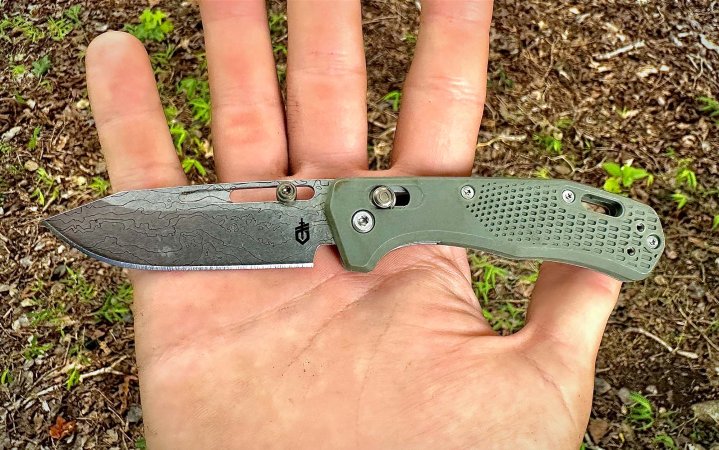
See It
Pros
- Easy and comfortable to carry
- One handed opening and closing
- Comfortable to use
Cons
- Not as “flippy” as some knives
Key Features
-
Blade Length:
2.98 inches -
Steel:
S30V -
Weight:
1.87 ounces -
Lock:
Pivot Lock -
Customizable blade, handle, and hardware -
Made in USA -
Price:
$175
With some knives, the color scheme is predetermined at the factory and you either like it or you don’t. But, the Gerber Assert is customizable in that you can choose the blade finish, hardware color, and handle color. I went with the topographic, stonewashed blade, a green handle, and orange back spacers. The process was fun and easy to do on the Gerber site, and they sent me my customized knife a few weeks later (custom orders take 12 to 15 days to ship).
I started carrying my new EDC knife daily and put it to use opening packages, cutting twine, and harvesting vegetables from the garden. After a few weeks of use the edge was still sharp enough to push cut paper. So, I grabbed a long piece of 2-foot wide cardboard and started cutting strips. After slicing through 20 feet of cardboard the edge finally dulled to the point it couldn’t push cut paper. After two minutes on the strop it was right back to slicing though—a testament to a good heat treat.
The Assert is a comfortable knife to carry and it’s the sort of blade that disappears in your pocket thanks to its size, deep carry clip, and light weight. You can one hand deploy the Assert with the adjustable thump stud or the fuller. Although, it doesn’t fire open like some of the best flippers on the market. But if you use your knife as a tool, rather than a fidget spinner, you’ll be happy with the action. — Scott Einsmann, gear editor
Read Next: Best Hunting Knives
Best Slicer: Spyderco Para Military 2
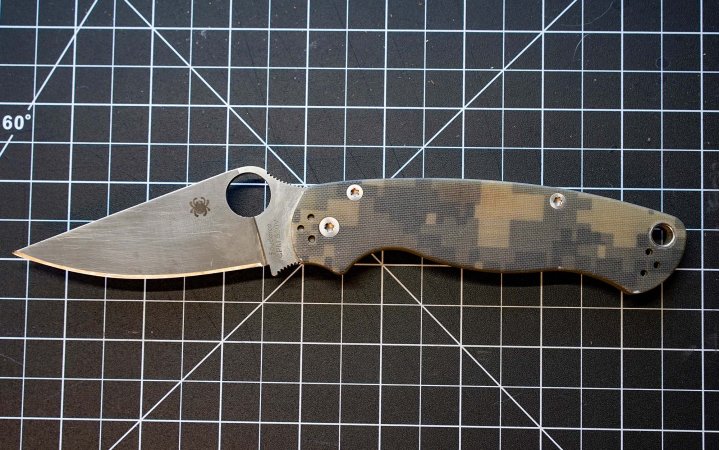
Scott Einsmann
See It
Pros
- Lots of sharpening life
- Good ergonomics
- Lefty friendly
Cons
- Hot spots created by the pocket when in the tip down position
- Delicate tip
Key Features
-
Blade Length:
3.42 inches -
Overall Length:
8.24 inches -
Weight:
3.9 ounces -
Blade Steel:
S30V (others available) -
Deployment Method:
Hole -
Compression lock -
G10 scales -
Made in the USA -
Price:
$180

Some knives have a lot of hype and then they fade away, but the Spyderco Paramilitary 2 is the complete opposite of those flashes in the pan. It’s stood the test of time and continues to be a top EDC knife because as Doug Marcaida would say, “It will cut.”
The PM2’s cut time performance was good, but what solidified the PM2 as the top slicer was when I lined up the five best cutters in the test and started cutting cardboard with them. I made a cut with each and then eliminated the one that had the most resistance. I did that until there was one left standing, and to no one’s surprise the PM2 was the champ. While not surprising that it won, it was nice to confirm its legendary slicing ability. — Scott Einsmann, gear editor
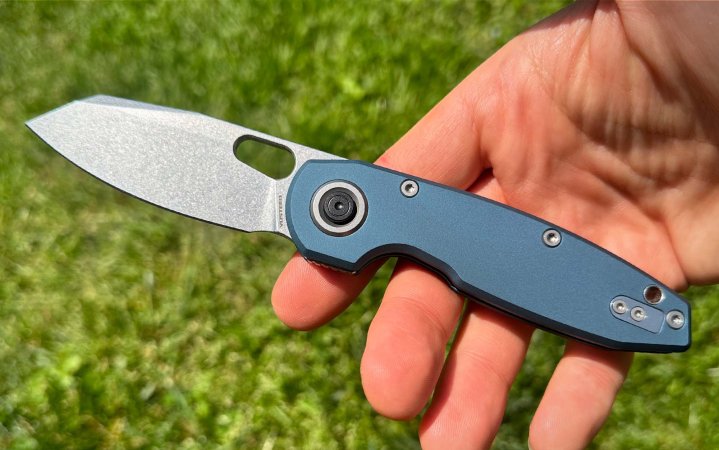
Photo by Scott Einsmann
See It
Pros
- Innovative lock
- Durable
- Good ergonomics
- Three deployment methods
-
Blade Length:
3.18 inches -
Blade Material:
Elmax or 154CM -
Aluminum Handle -
HRC:
58 to 62 -
Weight:
4.76 ounces -
Reversible Pocket Clip -
Vanchor lock -
Blade Thickness:
0.134 inch -
Price:
$130 to 170
The Vosteed Ankylo has a super lock, a great steel, and costs well under $200. That’s a fantastic value for a hard-use folder. It’s action isn’t the best I’ve tested, but it still flips well using either the flipper tab, front flipper, or blade hole. You can also bush down the lock release button and flip the blade out with a little wrist snap.

A look at the Ankylo’s action.
The Ankylo cuts surprisingly well for a thick blade. I found the cutting performance acceptable for most EDC tasks. The real magic of this knife is in its lock. There’s a metal insert in the scale that clicks securely into a cut out in the blade. A button on the pivot that compresses the lock and then the blade can be folded. It’s a well-executed design and it solves a lot of issues most button locks have. Mainly that a button lock can be accidentally unlocked while the knife is in use. But the Vanchor Lock put the button in a location that is very difficult to accidentally press .
The main downside of the Ankylo is that it is a thick, heavy knife. It can be a burden to carry. Yet, for times when you need a knife that can handle tough tasks, it’s a great one to have ivn your pocket. — Scott Einsmann, gear editor
Civivi Sendy
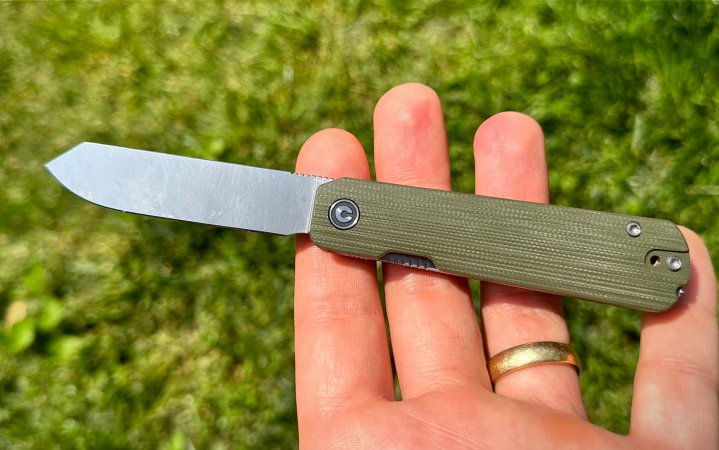
Photo by Scott Einsmann
See It
Pros
- Great knife, with a good steel
- Excellent action
- Hidden tools are out of the way until you need them
Cons
- Can only flip the blade open
Key Features
-
Tools:
Knife, tweezers, and metal toothpick -
Price:
$63 -
Nitro V blade -
Flipper -
Liner lock -
Lefty friendly
The Civivi Sendy has a thin, slicey blade that’s perfect for everything from slicing up a summer sausage for lunch to breaking down cardboard boxes. It has an excellent flipper action and the blade flies open. The only downside to deployment is that you have to use the flipper tab, there’s no option to slowly roll the knife open. The tweezers and toothpick are hidden in the knife’s handle. I’ve used the tweezers to remove splinters and pick up screws that fell into a tight spot. Aside from the obvious uses for the tooth pick, it’s also a good eating utensil and it’s handy for tying nail knots. — Scott Einsmann, gear editor
The Best High-End Pocket Knives
Oz Machine Co. Roosevelt
The Roosevelt isn’t a knife that’s meant to sit in a drawer or be handled with white gloves. It has a utilitarian finish and it’s been designed specifically to be carried. Keep that in mind if you’re looking to pick one of these up.
I put my Roosevelt through the cut test and it did great, but it didn’t blow the other knives out of the water. It’s a knife with a full-flat grind and a good blade shape—it’ll cut stuff. Where it shines is its incredible ergonomics, engineering, and build quality. The grip was the most comfortable and secure I tested. The amount of blade and handle the Roosevelt has for its folded size is an engineering marvel. It’s also incredibly light for its size. Of course, the build quality is top notch and it has an elite-level action.
If price and availability weren’t a factor, the Roosevelt would be my pick for the best EDC knife. I don’t think there’s a better designed and built knife for daily carry available. But, you just can’t get them without paying a ton or getting lucky on a drop.
Brown Knives Mini FSD-I
If you want an expensive folding knife with instantly recognizable quality, the FSD-I is your knife. It looks and feels high end without being gaudy. The action is the best I’ve experienced and it goes beyond being just smooth—it’s a controlled, hydraulic like smoothness. The detent is just strong enough for the blade to fire out with a reverse flick or the front flipper, but it’s not so strong that you can’t smoothly roll out the knife with your thumb. The machine work is impeccable and there are a lot of neat machining Easter eggs to find. As pretty as the knife is, it’s still a tool and it cuts very well thanks to its hollow grind.
Hinderer XM-18
I get that Rick Hinderer can be polarizing, but there’s no denying his company makes a superb overbuilt folder. The XM-18 is my favorite knife in this class and I think it lives up to the hype. For EDC the 3-inch, non-flipper variant is my top choice. I carry the 3.5-inch non flipper, which is also a great choice if you don’t mind its size.
Koenig Arius
The Arius is like the FSD in that it looks and feels like a quality knife. The flipper action is insanely good, but it’s kind of a one trick pony. My knife’s detent is a little too strong for a reliable reverse flick and it doesn’t roll out for the same reason. The pocket clip on mine is also too tight and I can’t fully clip it onto jeans. Yet, it’s still one of my favorite knives because of the deep hollow grind, great looks, comfortable ergonomics, and fun flipper action.
Things to Consider when Choosing a Knife
There is a lot to look at when choosing the best pocket knife in any given category. In the world of pocket knives, options range from $5 to $5,000. There are knives with blades that are under an inch up to nearly a foot. Blade steels range from barely better than a chunk of angle iron to the latest super-steels. Here are a few tips on how to sort through a variety of blades and find the right pocket knife for you.
The first thing you want to determine is what you intend to use the knife for. For example, a hard use knife has a much different intended use and environment than a kid’s first knife. One has to be able to pierce, pry, and have maximum grip, and one has to be light and easy to use and really only stand up to the abuse of whittling a stick. While considering how you’ll use your knife, realize that features come at a trade-off. For example, you can have a knife that slices well like the PM2, but it won’t be as durable as a thicker blade like a Benchmade Adamas.
Read Next: Best Survival Knives
Another big consideration is how easy the knife is to carry. For me, this is a big one. The shape and size of the knife, when closed, have the biggest effect on this. If I can’t get my hand past my knife to get other things in my pocket, that’s a real concern. Pocket clips also make a difference in how the knife rides and carries, and their designs are more important than you might think.
Finally, look at the blade steel. I have owned knives that performed and carried well, but the steel was lacking. That meant I was constantly sharpening it, or it was so hard and brittle that I was always fixing chips. Some steel is super easy to sharpen but won’t hold an edge, and some steel will cut forever, but take you an eternity to sharpen. The ideal steel finds a happy balance between the two. Also, avoid blades with ambiguous labels like “surgical stainless.” There’s a lot to learn about blade steels, but I think it’s worth the time investment.
FAQs
Knives on this list of best pocket knives range from less than $20, to well over $200. I have found that knives priced from $100-$250 usually offer the most for your money (with a few exceptions). You will generally get very good quality, good blade steel, well-thought-out design, good warranty, and a lot of trouble-free use.
This depends heavily on the intended use. Some applications require pure edge retention, while others favor steel with more toughness (resistance to breaking). For general use, S30V is a great steel that will hold an edge well, and will also sharpen up without too much trouble. It’s miles better than most blades steel out there, but it’s not a hard-to-sharpen and expensive super steel either.
Knife laws are sometimes complicated and arbitrary. Check with your local jurisdiction to be sure the type of knife you want is legal in your area. Knifeup.com and akti.org (American Knife and Tool Institute) both have large databases for state and local laws.
Top pocket knife brands include Benchmade, Spyderco, CRKT, Buck, Kershaw, Case, and Zero Tolerance.
Read Next: The Best Camping Knives
Final Thoughts on the Best Pocket Knives
I have been hooked on pocket knives since my dad gave me a Swiss Army Knife at age 5. Having a knife opened a world of possibilities to me at that time, and to this day, a pocket knife is an essential tool that I am never without.
The best pocket knives on this list have all been vetted, tested, and proven. Picking up any one of them will be a great addition to your collection or the perfect springboard to launch you into a knife addiction, I mean, hobby. Think of your knife as a tool: pick the tool that will best suit the work you are doing, and it will be the best pocket knife for you.
Read the full article here



